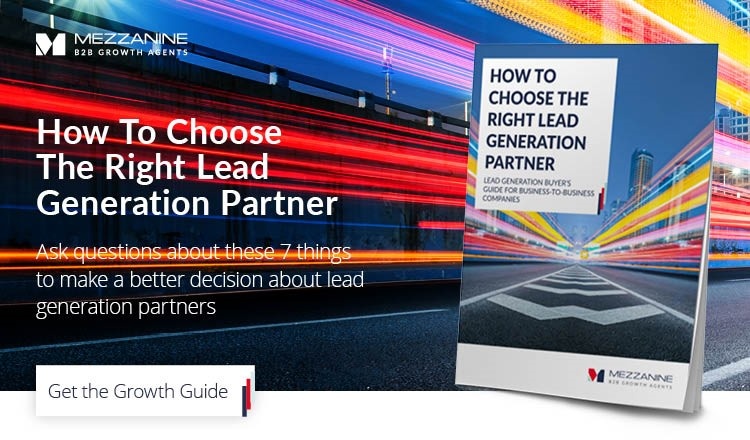How Much Should You Spend On Lead Generation?

One of the questions that executives often ask is "How much should we spend on lead generation?"
Chances are, if you own or lead a company that sells products and services to other companies rather than to consumers (so, a business-to-business or B2B company)—you might be trying to figure this out too. As revenue generation shifts increasingly towards lead generation and marketing (away from purely sales), it’s becoming a question that more leaders are wondering about. 
There isn't a one-size-fits-all answer to this question. Many factors determine how much a company should spend on lead generation. However, there are some rules of thumb that you can consider when looking at your budget.
These 5 variables will impact how much your business needs to spend on lead generation in order to be successful:
1. Your Industry
Companies in industries like software or design traditionally spend big on lead generation (15% of gross target revenue or more), while companies in commoditized industries with narrow profit margins spend quite a bit less (1 – 3% of gross target revenues). Not sure what the benchmarks are for your industry? You’re not alone – there isn’t a lot of data available on marketing and lead generation expenditures in the public domain. Check out the sites of your industry associations to see if they’ve published any reports on marketing and lead generation for the industry. These organizations often do studies across their membership to determine how much members spend on a variety of business functions, including marketing and lead generation.
2. Your Company Size
Large companies tend to spend a smaller percentage of their revenue on lead generation. Smaller companies typically spend a higher percentage because they need to build up their brand awareness and reputation in support of lead generation. For example, a company with revenue of $150 million might generate a tremendous ROI from spending just 1% of revenue on lead generation. But an organization with revenue of $2 million will need to spend quite a bit more than 1%, because $20,000 won't generate much in the way of valuable leads.
3. Your Company’s Position
This one is counter-intuitive. If your company is known as the leader in its industry (ie, it already has high awareness and credibility), it will spend less on lead generation than a firm that does not have awareness and credibility. That’s because in B2B, awareness and credibility are half of the lead generation equation. Without awareness and credibility, a B2B company can spend unlimited amounts of money on lead generation activities and not necessarily produce returns – because no one wants to do business with an unknown, untrusted firm. B2B companies need to have a balance between how much they spend on lead generation and how much they spend on brand activities. But keep in mind that a leading company might be able to spend less on lead generation, but they’ll likely be spending more than average on their brand activities.
4. Your Target Market
Some customers are harder to reach than others. If you’re looking for enterprise clients or are pursuing C-Suite executives, your lead generation costs will be higher than companies that sell into the mid-market which is not so difficult to access.
5. Your Scope of Operations
Companies that are pursuing global leads should budget for higher costs than those focusing on a small geographic area. For example, if you're hoping to sell across multiple continents, your lead generation budget will be larger than if you’re exclusively targeting one city. Factor things like translation of collateral and websites into your lead generation budget.
Now that you’ve considered the 5 variables that affect how much you will need to spend in lead generation to be successful, here are a couple of other considerations to help you identify a reasonable budget range.
General Marketing and Lead Generation Budgets
In general, B2B companies spend 2% to 5% of gross revenue as their overall marketing budget, which is split between lead generation and brand activities. For example, if your target revenue for this year is $10 million, spending $200,000 to $500,000 in total on marketing activities is the typical range. Most B2B companies start in this 2% to 5% range, then consider the five factors above to shift up and down as appropriate. A technical services company that sells to risk managers in the global nuclear industry might budget more than 5%, given the scope and challenge of its tough-to-reach target market. But a trucking company with $300 million in revenue that has just celebrated its 50th anniversary might be fine with a marketing budget of less than 1%. Within this 2 – 5% range, lead generation will make up about 50% - although keep in mind the need to balance lead generation with brand activities.
The ROI Consideration
Calculating ROI on marketing and lead generation is more difficult than it sounds due to the complexity of the buying process (it’s not as straight forward as some people like to think it is). But there is a basic framework that will help you get a general sense of what your lead generation budget should be.
If your company sells a service that has a gross margin of 40% and about 30% of your leads convert to deals, then you’ll produce $12,000 of profit for every $100,000 of leads you generate. If your average deal is $50,000, then a lead is worth $6,000. That means to break even you can spend $6,000 for every lead you generate. Of course you don’t want to just break even. If you want to produce 100% ROI on your lead generation, you’d aim to spend $3000 for every lead you generate – based on the parameters above. Use the equation below to figure out your lead generation ROI:
Gross Margin: 40%
Conversion from Lead to Deal: 30%
Average Deal Value: $50,000
Target ROI: 100%
Gross Margin * Conversion Rate * Deal Value
(-1 – Target ROI)
100%
Another way to consider this: if you generate $1M of opportunities per year, and those opportunities convert at a rate of 40% to deals, at a gross margin of 40%, then you get 100% ROI if you are spending $6700 per month on lead generation.
For additional tips on ROI and budgeting, read Getting ROI From B2B Lead Generation. Keep in mind that spending more doesn’t always equal higher revenues - strategic planning and efficient execution makes a big impact.
The best way to figure out the right lead generation budget for your business is to track your spending and your results year over year. Over time you will see patterns that will help you determine the budget that gives you the best leads.
Need help choosing which lead generation partner to work with? Download our whitepaper to learn how to make the right choice.
.png?width=2361&height=488&name=Mezzanine%20Logo_Horiz_RGB_on%20blue%20(1).png)

